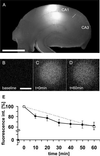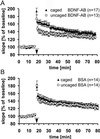A caged Ab reveals an immediate/instructive effect of BDNF during hippocampal synaptic potentiation
- PMID: 11724927
- PMCID: PMC64745
- DOI: 10.1073/pnas.251326998
A caged Ab reveals an immediate/instructive effect of BDNF during hippocampal synaptic potentiation
Erratum in
- Proc Natl Acad Sci U S A 2002 Jan 8;99(1):541
Abstract
Neurotrophins have been shown to be involved in functional strengthening of central nervous system synapses. Although their general importance in this process is undisputed, it remains unresolved whether neurotrophins are truly mediators of synaptic strengthening or merely important cofactors. To address this question, we have devised a method to inactivate endogenous brain-derived neurotrophic factor (BDNF) with high time resolution by "caging" a function-blocking mAb against BDNF with a photosensitive protecting compound. Different assays were used to show that this inactivation of the Ab is reversible by UV light. Synaptic potentiation after theta-burst [corrected] stimulation in the CA1 region of acute hippocampal slices was significantly less when applying the unmodified Ab compared with the caged Ab. Importantly, photoactivation of the caged Ab during the time of induction of synaptic enhancement led to a marked decrease in potentiation. Our experiments therefore strengthen the view that endogenous BDNF has fast effects during induction of synaptic plasticity. The results additionally show that caged Abs can provide a tool for precise spatiotemporal control over endogenous protein levels.
Figures





Similar articles
-
Relative contribution of endogenous neurotrophins in hippocampal long-term potentiation.J Neurosci. 1999 Sep 15;19(18):7983-90. doi: 10.1523/JNEUROSCI.19-18-07983.1999. J Neurosci. 1999. PMID: 10479698 Free PMC article.
-
Neurotrophins and hippocampal synaptic transmission and plasticity.J Neurosci Res. 1999 Oct 1;58(1):76-87. J Neurosci Res. 1999. PMID: 10491573 Review.
-
Regulation of hippocampal synaptic plasticity by BDNF.Brain Res. 2015 Sep 24;1621:82-101. doi: 10.1016/j.brainres.2014.10.019. Epub 2014 Oct 23. Brain Res. 2015. PMID: 25451089 Review.
-
Restoration of long-term potentiation in middle-aged hippocampus after induction of brain-derived neurotrophic factor.J Neurophysiol. 2006 Aug;96(2):677-85. doi: 10.1152/jn.00336.2006. Epub 2006 May 17. J Neurophysiol. 2006. PMID: 16707719 Free PMC article.
-
The involvement of brain-derived neurotrophic factor in hippocampal long-term potentiation revealed by gene targeting experiments.J Physiol Paris. 1996;90(3-4):157-64. doi: 10.1016/s0928-4257(97)81415-5. J Physiol Paris. 1996. PMID: 9116659
Cited by
-
BDNF Val66Met Genetic Polymorphism Results in Poor Recovery Following Repeated Mild Traumatic Brain Injury in a Mouse Model and Treatment With AAV-BDNF Improves Outcomes.Front Neurol. 2019 Nov 7;10:1175. doi: 10.3389/fneur.2019.01175. eCollection 2019. Front Neurol. 2019. PMID: 31787925 Free PMC article.
-
Brain-derived neurotrophic factor promotes long-term potentiation-related cytoskeletal changes in adult hippocampus.J Neurosci. 2007 Mar 14;27(11):3017-29. doi: 10.1523/JNEUROSCI.4037-06.2007. J Neurosci. 2007. PMID: 17360925 Free PMC article.
-
Brain-derived neurotrophic factor triggers transcription-dependent, late phase long-term potentiation in vivo.J Neurosci. 2002 Sep 1;22(17):7453-61. doi: 10.1523/JNEUROSCI.22-17-07453.2002. J Neurosci. 2002. PMID: 12196567 Free PMC article.
-
Mechanisms and time course of vocal learning and consolidation in the adult songbird.J Neurophysiol. 2011 Oct;106(4):1806-21. doi: 10.1152/jn.00311.2011. Epub 2011 Jul 6. J Neurophysiol. 2011. PMID: 21734110 Free PMC article.
-
Essential role for vav Guanine nucleotide exchange factors in brain-derived neurotrophic factor-induced dendritic spine growth and synapse plasticity.J Neurosci. 2011 Aug 31;31(35):12426-36. doi: 10.1523/JNEUROSCI.0685-11.2011. J Neurosci. 2011. PMID: 21880903 Free PMC article.
References
-
- Lewin G R, Barde Y-A. Annu Rev Neurosci. 1996;19:289–317. - PubMed
-
- Davies A M. Trends Neurosci. 1994;17:195–199. - PubMed
-
- Blöchl A, Thoenen H. Eur J Neurosci. 1995;7:1220–1228. - PubMed
-
- Griesbeck O, Canossa M, Campana G, Gärtner A, Hoener M C, Nawa H, Kolbeck R, Thoenen H. Microsc Res Technol. 1999;45:262–275. - PubMed
-
- Thoenen H. Science. 1995;270:593–598. - PubMed
Publication types
MeSH terms
Substances
LinkOut - more resources
Full Text Sources
Other Literature Sources
Miscellaneous

